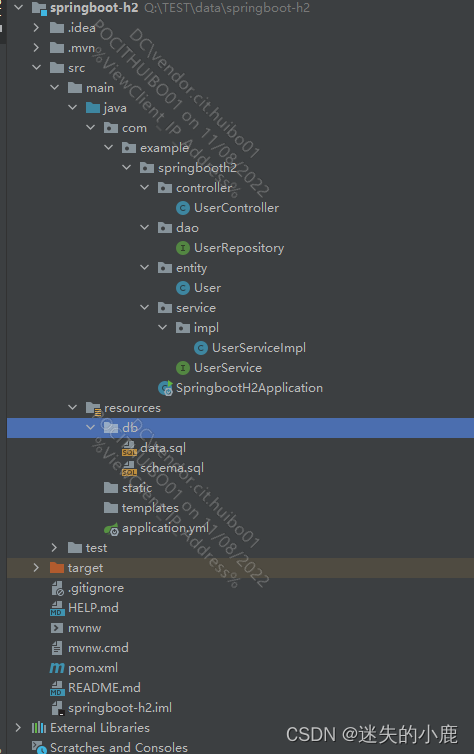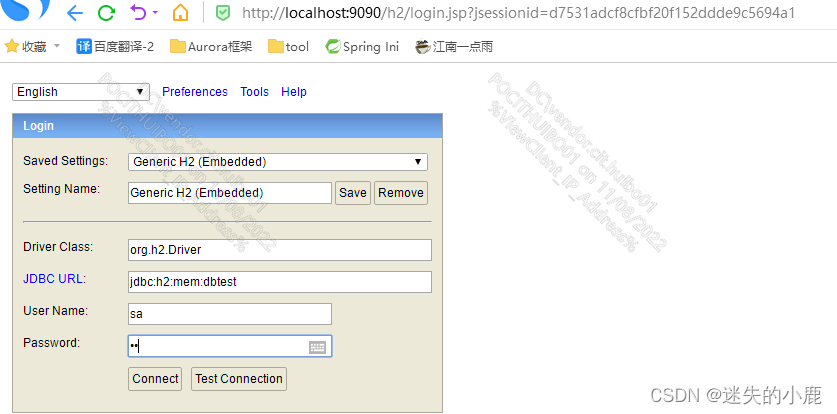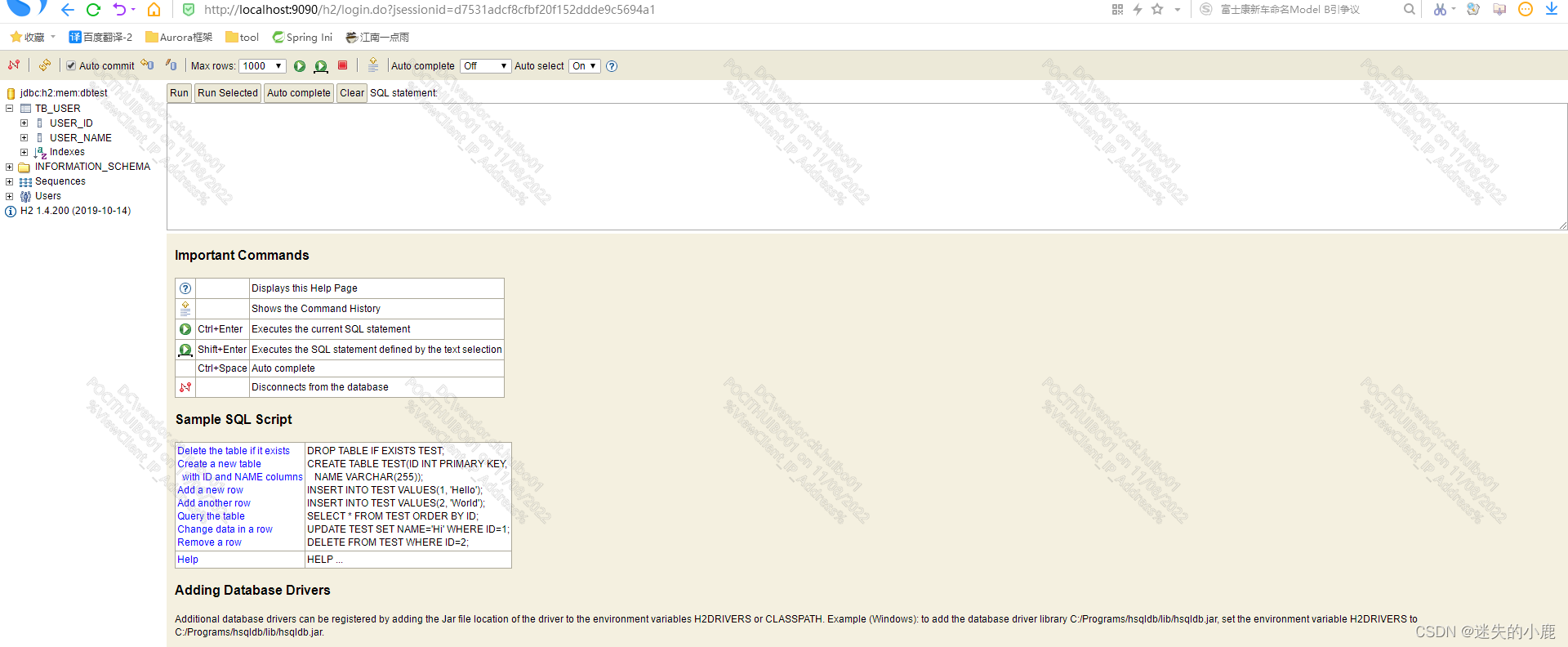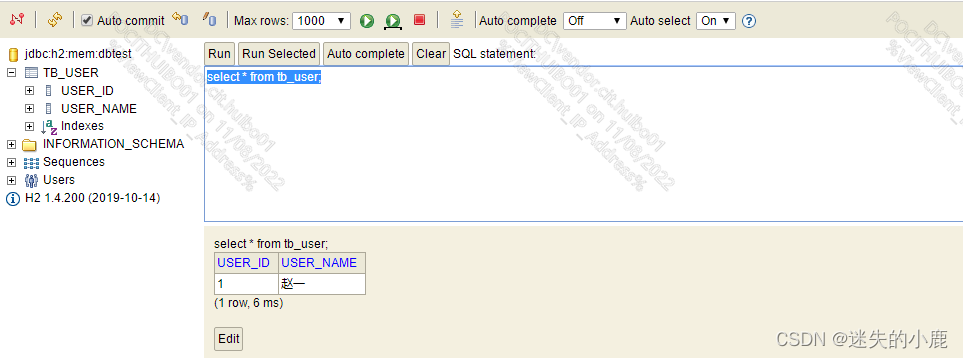添加依赖
<dependencies>
<dependency>
<groupId>com.h2database</groupId>
<artifactId>h2</artifactId>
<scope>runtime</scope>
</dependency>
<dependency>
<groupId>org.springframework.boot</groupId>
<artifactId>spring-boot-starter-data-jpa</artifactId>
</dependency>
</dependencies>
项目结构

配置H2和JPA注入参数
server:
port: 9090
spring:
datasource:
driverClassName: org.h2.Driver
url: jdbc:h2:mem:dbtest
username: sa
password: sa
h2:
console:
enabled: true
path: /h2
settings:
web-allow-others: true
jpa:
hibernate:
ddl-auto: update
show-sql: true
sql:
init:
platform: h2
schema-locations: classpath:db/schema.sql
data-locations: classpath:db/data.sql
配置数据库的表结构
配置数据库的表结构schema.sql
create table if not exists tb_user (
USER_ID int not null primary key auto_increment,
USER_NAME varchar(100)
);
初始化数据
数据文件 data.sql, 默认插入一条
INSERT INTO tb_user (USER_ID, USER_NAME)
VALUES (1, '赵一');
测试
JDBC URL jdbc:h2:mem:dbtest
User Name sa
Password sa
页面访问路径 localhost:9090/h2



案例
使用H2存放用户表,并通过JPA操作用户数据
实体类
给User添加@Entity注解,和@Table注解
package com.example.springbooth2.entity;
import javax.persistence.Entity;
import javax.persistence.Id;
import javax.persistence.Table;
@Entity
@Table(name = "tb_user")
public class User {
@Id
private int userId;
private String userName;
public int getUserId() {
return userId;
}
public void setUserId(int userId) {
this.userId = userId;
}
public String getUserName() {
return userName;
}
public void setUserName(String userName) {
this.userName = userName;
}
}
Dao继承JpaRepository
package com.example.springbooth2.dao;
import com.example.springbooth2.entity.User;
import org.springframework.data.jpa.repository.JpaRepository;
import org.springframework.stereotype.Repository;
@Repository
public interface UserRepository extends JpaRepository<User, Integer> {
}
service
package com.example.springbooth2.service;
import com.example.springbooth2.entity.User;
import java.util.List;
public interface UserService {
void addUser(User user);
List<User> list();
}
package com.example.springbooth2.service.impl;
import com.example.springbooth2.dao.UserRepository;
import com.example.springbooth2.entity.User;
import com.example.springbooth2.service.UserService;
import org.springframework.stereotype.Service;
import javax.annotation.Resource;
import java.util.List;
@Service
public class UserServiceImpl implements UserService {
@Resource
private UserRepository userDao;
@Override
public void addUser(User user) {
userDao.save(user);
}
@Override
public List<User> list() {
return userDao.findAll();
}
}
Controller
package com.example.springbooth2.controller;
import com.example.springbooth2.entity.User;
import com.example.springbooth2.service.UserService;
import org.springframework.web.bind.annotation.GetMapping;
import org.springframework.web.bind.annotation.PostMapping;
import org.springframework.web.bind.annotation.RequestMapping;
import org.springframework.web.bind.annotation.RestController;
import javax.annotation.Resource;
import java.util.List;
@RestController
@RequestMapping("/user")
public class UserController {
@Resource
private UserService userService;
@PostMapping("add")
public User add(User user) {
userService.addUser(user);
return user;
}
@GetMapping("list")
public List<User> list() {
return userService.list();
}
}
测试
localhost:9090/user/list
